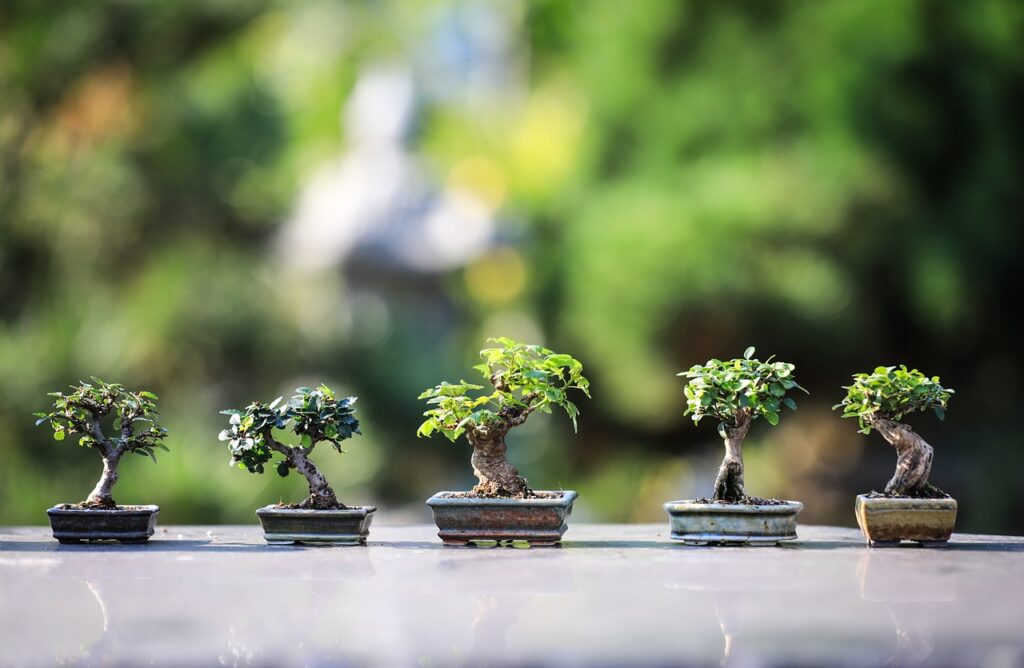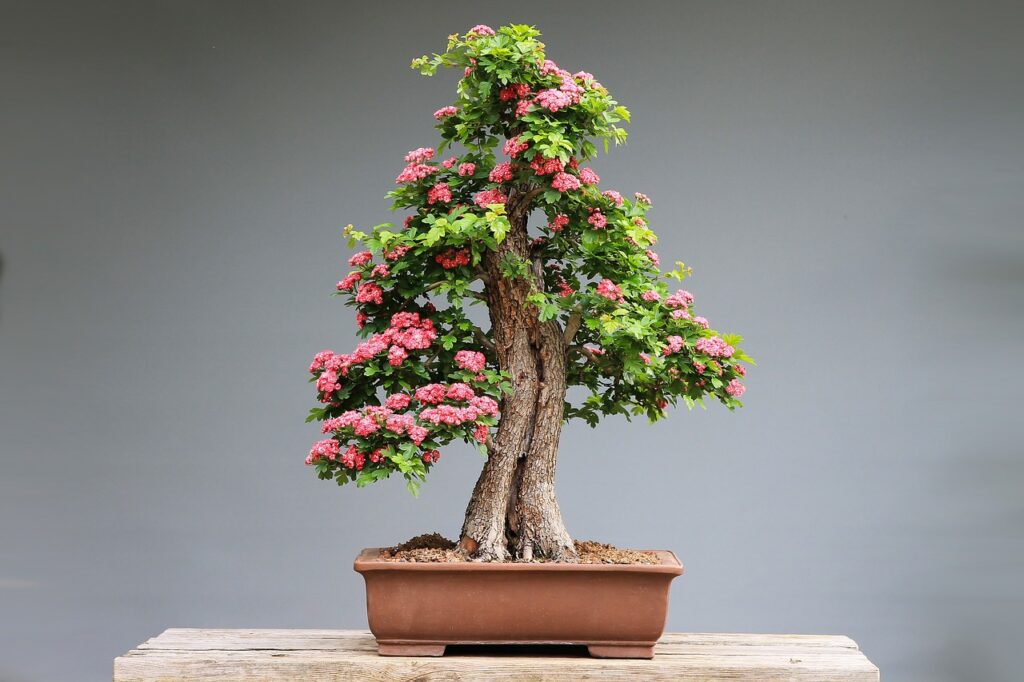The bonsai tree is one of the most prominent symbols of Japanese culture. They are believed to provide positive energy and luck in Japan. Thus, you’ll often see them in homes, movies, temples, and public gardens. These beautiful trees are also known to bring luck and fortune. In fact, in Japan, giving a bonsai tree is believed to double the fortune to its owner and bring peace and serenity in life. No wonder they are also popular as a gift!
As this magnificent tree is deeply embedded in Japanese culture, there’s still so much to learn about it. By reading this article, you will understand of the significance and history of the bonsai tree and how deeply its rooted Japanese culture for centuries.
A Brief History of Bonsai Trees
The word bonsai (盆栽) comes from the kanji bon (盆), which means tray or basin and sai (裁), which means plating. Putting these two kanji together create the word bonsai.
700-1200 CE: The Origin of Bonsai

While strongly tied to Japanese culture, this art form actually came from the Chinese art form of penjing or penzai, which is the ancient art of creating artistically crafted trees and other plants. This artful technique started around 700 CE. The Chinese would grow dwarf trees in various sized containers. Chinese monks migrated over to Japan and different parts of Asia and brought with them some examples of penzai.
Over the next few hundred years, the Japanese took the penzai art form and added their own techniques to making miniature trees and later called it bonsai. The modern idea of sculpting trees did not really become mainstream until sometime between the 12th and 13th century. By this time, Japan’s most wealthy and elite members of society were showcasing their bonsai trees as it quickly became a symbol of wealth and honor. One of the first earliest written depictions of this art form came from a scroll called the Kasuga Gongen Genki by Takashina Takakane. This scroll dates all the way back to 1309.
1200-1600 CE: Harmonious Connection with Nature

As Buddhism and bonsai trees alike came to Japan during the Kamakura period (12th century), the common belief amongst Buddhist monks was that planting and caring for bonsai trees was a process that was meditative, reflective, and promoted a harmonious connection with nature. After that point, Buddhist monks were the main teachers of the practice to Japan for many years. Planting the tree and caring for it became a lesson in the Buddhist philosophy of Zen, which mainly focuses on truth, goodness, and beauty.
The Good Hearted Samurai
To further the plant’s popularity, Zeami Motokiyo wrote a very successful noh play around 1383. Japanese people loved this play as it was about a samurai who was poor, but still a good-hearted person. When a monk was suffering from a cold during his travel, the samurai came to his aid. He burned his potted bonsai tree, which one of his last belongings. In the end, the travelling monk was actually a disguised officer, who rewarded the samurai for his help. Not only did Japanese people love the play, but the bonsai tree then became even more synonymous with prosperity, luck, and status.
Wabi-sabi
This was also the time when the Japanese concept of wabi-sabi started becoming popular. Wabi-sabi is deeply rooted in Japanese culture as the Japanese began showing off the bonsai tree in rougher textures, such as pieces of deadwood, to show the passage of time and nature. This Buddhist philosophy looks at imperfections of nature and garnering admiration for them in either bare or blooming states. The concept of wabi-sabi is featured in other Japanese forms of art like origami, tea ceremonies, and flower arrangement.
1600-1900 CE: The Rise of Bonsai Trees in an Isolated Japan

By the time the 17th century came around, the Japanese arborous art form was completely mainstream transcending class and wealth. Growing bonsai tress became deeply rooted into Japanese culture. It also brought on a Buddhist philosophy of minimalism, or stripping back all non-essential parts, which later became more commonly known as pruning. This became a huge part of designing and creating an aesthetically pleasing bonsai tree. By the end of the 18th century, Japan was holding competitions for trees.
It is important to note that during this time, Japan had closed its borders to most of the world around 1639 and basically remained isolated for over 200 years. Japanese implemented a policy of seclusion, or “Sakoku” to prevent outside cultures from influencing the strong Japanese culture. Borders finally opened again in 1853. Only a handful of foreigners were ever allowed into Japan during this time. One such person was German physician, Engelbert Kaempfer. Kaempfer spent a lot of time in Japan and wrote a book called “The History of Japan” where he mentions dwarfed trees that are planted in pots. This was one of the first major introductions of bonsai trees to the western world.
After the Meiji revolution and Japan was open again, the Meiji Emperor wanted to his government to show more interest in the trees and have them displayed all around his palace. Soon after, the bonsai tree was showcased in 1876 in the Philadelphia Exposition, then later in Paris, London, and Vienna. This helped solidify the miniature trees as a true symbol of Japanese culture and art. By the 1900’s, the tree development continued by growing more of the species from seeds, saplings, and cuttings. There were over 150 different bonsai tree species by 1940, which started to be sold off to foreign countries in both America and Europe.
Modern Day Bonsai
Today, Japanese masters continue to pass their knowledge of bonsai trees and the teachings that go with it. The bonsai tree is now considered to be a national treasure of Japan as it has been so well regarded for so many centuries. Caring for these trees has become an art form, and has evolved for many people into a way of life, a way of thinking, and a way of practicing patience and sympathy. This attitude is well reflected in the Japanese people to this day.
The Oldest Bonsai
Furthermore, bonsai trees are well known to live for hundreds of years. Many famous miniature trees have been known to reach 500, 700, and even over 1000 years old. The oldest of these trees is said to be in the Crespi Bonsai Museum in Italy, which has been estimated to be over a thousand years old. In the United States, the oldest is a 400-year-old five needle pine bonsai in the US National Arboretum, which was gifted to the US in 1976. However, the best of these trees are arguably still located in Japan.
Karate Kid
The popularity of this art form in modern times was heightened even more in the 1984 movie The Karate Kid. The movie taught a new generation of people about Japanese culture and what the bonsai tree represents to them in guiding one’s life. Mr. Miyagi teaches him focus, discipline, and looking inside oneself all with the tree.
The popularity of the Karate Kid film series was revived when in 2018 a sequel was released known as Cobra Kai.
Famous Bonsai Trees
In Japan, there are many famous bonsai trees throughout the country. In Omiya, Japan, there is a juniper in the Mansei-en nursery which is about a thousand years old. The same nursery also holds a 700-year-old Shimpaku juniper. One of the most expensive trees in the world comes from a centuries old bonsai tree that sold for $1.3 million at the World Bonsai Convention in Saitama, Japan. At these conventions, hundreds of these amazing trees are displayed for all to enjoy. Other famous bonsai trees in Japan include the Meiji Shrine in Tokyo and at a shop called Moriame Ginza in Ginza. The beautiful trees help define the Japanese culture for all who see them.
The bonsai tree has become one of the fundamental symbols of Japan and represents the struggle for inner peace, patience, and a connection with nature. Many of these trees have been passed down for hundreds of years, often from family member to family member. They also reflect the time and effort that people put into these glorious plants. The Buddhist tradition of caring for nature and understanding its connection to the self has shaped the way Japanese people look at life in general. Because of this, the bonsai trees have become an integral part of the Japanese culture.
Recommended Further Reading
If you are looking to start having your own bonsai trees, there are plenty of resources available that will help you get started. Whether you are a beginner or an expert, there are many books to guide you. One of these books called Bonsai Basics by Christian Pessey, which is an ideal book for beginners. The book breaks down the basics in an easy way for you to get used to the different styles and techniques. There are also Bonsai Master Class by Craig Coussins for the more advanced enthusiast, which feature more advanced tips for bonsai care.



No Comments